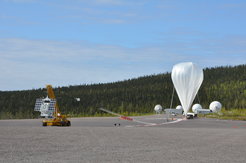500 days until the launch of Sunrise III
The Sunrise III mission will look at the Sun from the stratosphere equipped with three new scientific instruments.
In the summer of 2022, the balloon-borne solar observatory Sunrise will embark on its third stratospheric flight. From the airborne observation site more than 35 kilometers above the Earth's surface, the observatory will enjoy a unique view of the Sun during the several-day flight from northern Sweden to Canada: around the clock, undisturbed by air turbulences in the Earth's atmosphere, and with access to the ultraviolet radiation from our star. Equipped with a 1-meter telescope, three new scientific instruments and a sophisticated image stabilization system, the mission, led by the Max Planck Institute for Solar System Research (MPS) in Germany, will thus enable unprecedented observations of the solar surface and the adjacent, overlying layers of the solar atmosphere. In the remaining 500 days until launch, the international team of scientists and engineers at MPS will assemble all subsystems before Sunrise III sets off for Sweden.
On June 1, 2022, the launch window opens for Sunrise III. As with the first two flights, which also took off from the Swedish Space Cooperation's (SSC) Esrange Space Center in Kiruna, northern Sweden, a giant, helium-filled balloon will carry the three-ton observatory into the stratosphere. Once it has arrived there, circumpolar winds capture it and carry it westward. During the several-day flight north of the Arctic Circle, the Sun does not set for Sunrise, so that the observatory can look at it without interruption. Sunrise then lands on a parachute in the uninhabited wilderness of northeastern Canada.

Twice already, this adventurous concept has worked. In 2009 and 2013, the data storage units recovered from the landing site contained unparalleled observational data. Among other things, researchers were able to identify for the first time the smallest building blocks of the solar magnetic field at the solar surface and to visualize structures only 50 kilometers in size that show up in ultraviolet light from the Sun. Compared to the Sun's diameter of about 1.4 million kilometers, that is tiny.
In the meantime, solar research has not stood still. With a mirror diameter of four meters, the Daniel K. Inouye solar telescope in Hawaii for example enables solar observations with unprecedented spatial resolution; space missions such as ESA’s Solar Orbiter look at the Sun from a very close distance. But the Sunrise mission has also evolved. "Sunrise III is a necessary addition to ongoing solar research projects," says Professor Sami K. Solanki, director at MPS and Principal Investigator of the Sunrise missions. "The mission provides access to data that no Earth-based telescope or spacecraft can currently provide," he adds.

Sunrise III's focus is on a layer about 1000 kilometers thick above the Sun's visible surface, the lower chromosphere. Unlike previous missions, Sunrise III can measure the comparatively weak magnetic fields in this region. They are considered key to the whole range of dynamic processes in the solar atmosphere. The observational data that is expected will achieve an unprecedented altitude resolution: more precisely than before, the data can be assigned to an exact altitude above the solar surface. "The altitude information is crucial to understand the processes in the solar atmosphere in detail," says MPS scientist Andreas Lagg, Sunrise III project manager.
This unique view is made possible by Sunrise III's three new scientific instruments that use the light provided by Sunrise’s 1-meter telescope. The instrument SUSI (Sunrise UV Spectropolarimeter and Imager) was developed and built at MPS; the instrument TuMag (Tunable Magnetograph) is provided by a Spanish consortium led by the Instituto de Astrofísica de Andalucía (IAA) and the instrument SCIP (Sunrise Chromospheric Infrared Spectro-Polarimeter) is provided by a Japanese consortium led by the National Astronomical Observatory of Japan (NAOJ). The Leibniz Institute for Solar Physics in Germany is responsible for the image stabilization system. The five-meter high gondola, the framework of Sunrise III, is also a redevelopment led by the Applied Physics Laboratory at Johns Hopkins University in the USA.

The individual teams are already working on their respective contributions. In the coming months, mission preparations will enter their decisive phase: one by one, all components - gondola, instruments and image stabilization system - will arrive at MPS for integration. At the end of the year, the complete and functional observatory is expected to look at the Sun for the first time - but still earthbound through the open door of the balloon hall at MPS. In early 2022, Sunrise III, once again disassembled into subsystems, will then travel to Kiruna and be prepared for launch. The adventure begins again.














